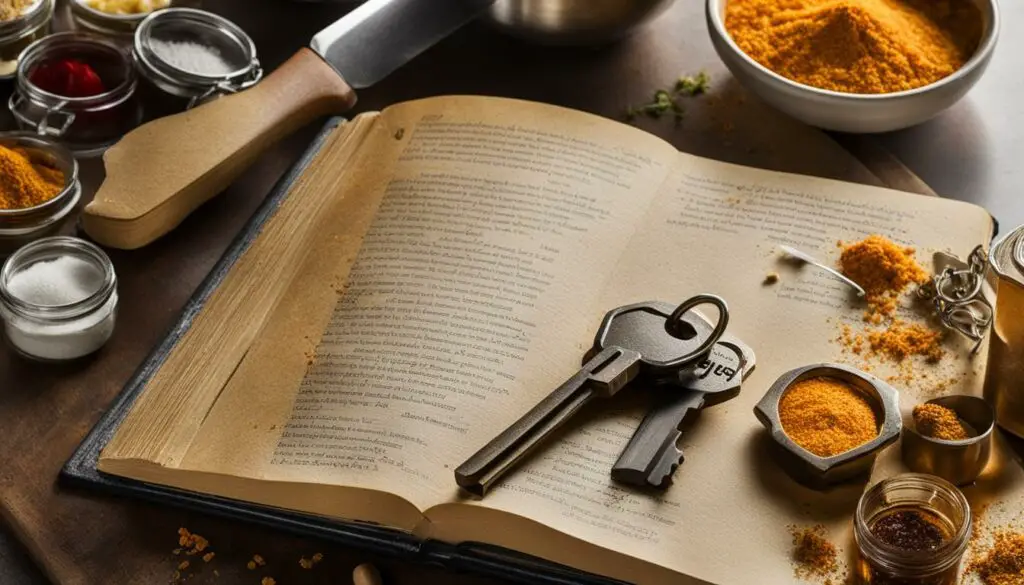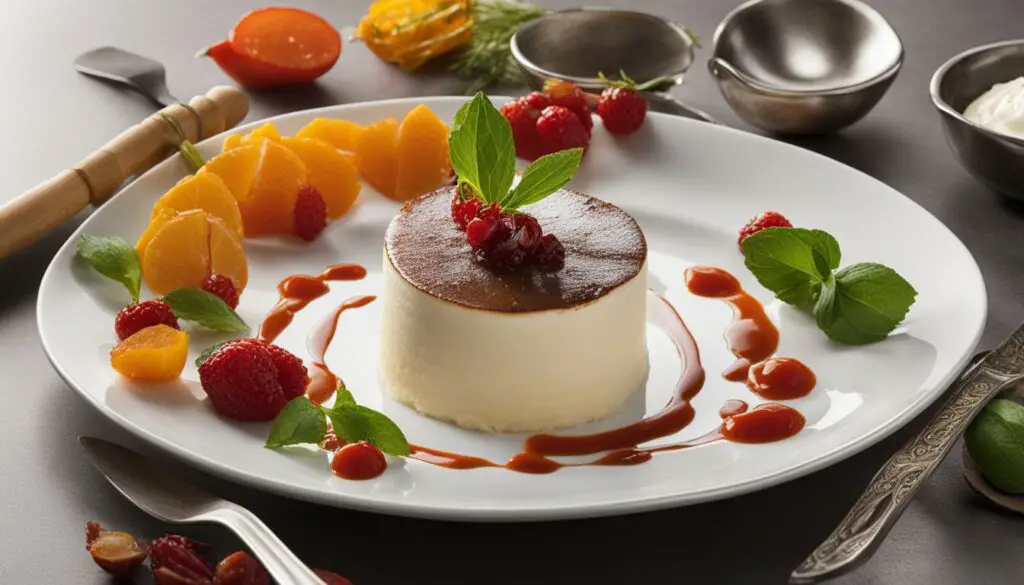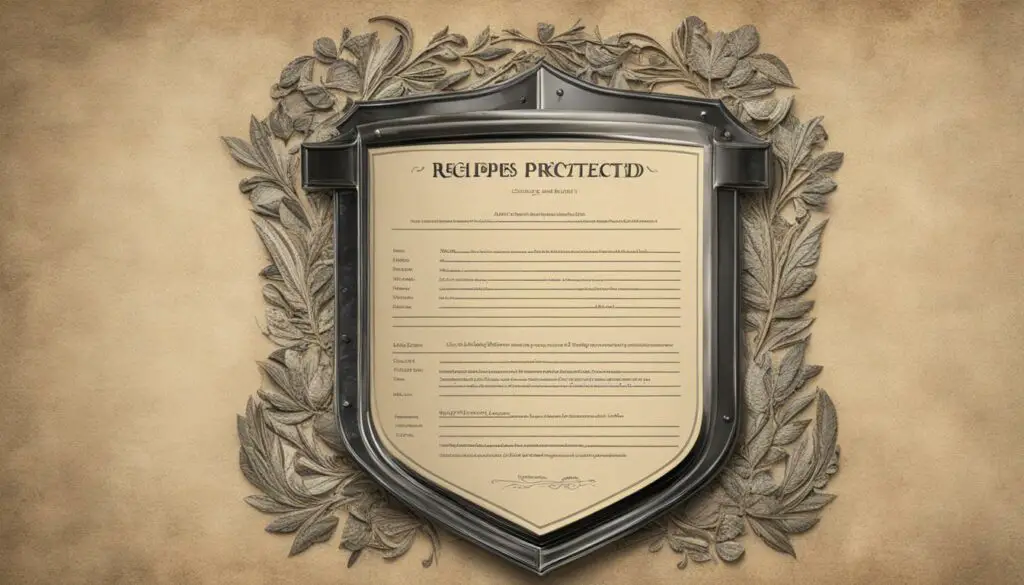Recipes are valuable assets in the food industry, but protecting them can be challenging. Intellectual property laws provide different forms of protection for culinary creations, such as patents, trademarks, copyrights, and trade secrets. However, each type of protection has limitations and requirements, affecting their applicability to recipes. Understanding the legal landscape is crucial for chefs, restaurants, and food businesses looking to safeguard their unique recipes.
Contents
- 1 The Challenge of Intellectual Property Protection for Recipes
- 2 Copyright Protection for Recipes
- 3 Trade Secret Protection for Recipes
- 4 Patent Protection for Recipes
- 5 Trademark Protection for Culinary Creations
- 6 Using a Combination of Intellectual Property Protections
- 7 Can You Patent a Recipe? Examining Patent Eligibility
- 8 Conclusion
- 9 FAQ
- 9.1 Can you trademark a recipe?
- 9.2 How can you trademark a recipe?
- 9.3 What is the process for trademarking a recipe?
- 9.4 Can you patent a recipe?
- 9.5 How can you patent a recipe?
- 9.6 How can you protect a recipe?
- 9.7 What is the best way to protect a recipe?
- 9.8 Can you copyright a recipe?
- 9.9 How can you copyright a recipe?
- 9.10 Can you protect a recipe as a trade secret?
- 10 Source Links
Key Takeaways:
- Intellectual property laws offer various forms of protection for recipes in the food industry.
- Recipes can be protected through patents, trademarks, copyrights, and trade secrets.
- Trademarks can safeguard the distinctive names or logos associated with culinary creations.
- Copyrights can protect recipes that exhibit substantial literary expression.
- Trade secrets can be used to maintain the confidentiality of valuable secret recipes.
The Challenge of Intellectual Property Protection for Recipes
Establishing intellectual property rights for recipes can be a complex process due to the unique nature of recipes as a combination of ingredients and cooking methods. While intellectual property laws offer different forms of protection, including trademarks, copyrights, and trade secrets, each type of protection has its limitations when it comes to safeguarding recipes.
Recipes often lack the novelty required for patent protection since they are frequently variations of existing ones. While trademark protection can safeguard the distinctive name or appearance of a food product, it does not extend to the recipe itself. Copyright protection, on the other hand, is limited to recipes that exhibit substantial literary expression beyond a simple list of ingredients and instructions.
Trade secret protection can be utilized to prevent the misappropriation of secret recipes by employees or competitors. However, there is a lack of consensus among courts regarding the circumstances under which a recipe may be copyrightable or protected as a trade secret.
In summary, protecting a recipe poses challenges due to the nature of recipes and the limitations of the available intellectual property protections. Trademarks protect names and appearances, copyrights cover substantial literary expression, and trade secrets preserve confidential recipes. However, navigating the legal landscape requires careful consideration of each protection’s requirements and limitations.
To gain a better understanding of the complexities involved, let’s explore the specifics of trademark protection, copyright protection, and trade secret protection for recipes in the sections that follow.
Copyright Protection for Recipes

Copyright law serves as a crucial tool for safeguarding intellectual property, including literary works. With regard to recipes, the question arises: can a recipe be protected by copyright? Early court cases recognized the copyrightability of recipes, but subsequent rulings have imposed stricter requirements.
To be eligible for copyright protection, a recipe must go beyond a simple list of ingredients and instructions. It needs to exhibit substantial literary expression, such as additional commentary, creative descriptions, or literary elaboration. As a result, basic or straightforward recipes may not meet the threshold for copyright protection.
However, recipes that incorporate literary elements or unique elaborations can qualify for copyright protection. These recipes demonstrate the necessary creativity and originality to be considered literary works and fall within the scope of copyright protection.
Note: Copyright law protects original expressions of ideas, not the ideas themselves. Therefore, while multiple recipes may use similar ingredients and cooking methods, the specific expression of each recipe can be protected by copyright.
Nevertheless, copyright protection for recipes continues to be an area where interpretations may vary. Courts have yet to establish a clear standard regarding the extent of creativity necessary to meet the threshold for copyrightability. This lack of consensus has led to differing rulings in copyright infringement cases involving recipes.
Ultimately, copyright protection offers a means to safeguard unique recipes that exhibit literary expression beyond a mere list of ingredients and instructions. By recognizing recipe creations as literary works, copyright law contributes to the protection of the culinary industry’s creativity and innovation.
Trade Secret Protection for Recipes

Trade secret law provides valuable protection for confidential information, including recipes, that have economic value and are kept secret. Some recipes can be considered trade secrets if they meet specific requirements:
- Not publicly known: A recipe must be kept confidential and not be widely known or readily accessible to the public.
- Economic benefit: The recipe should provide a competitive advantage or economic benefit to its owner by being confidential.
- Reasonable efforts to maintain secrecy: To protect a recipe as a trade secret, businesses must establish and enforce strict measures to maintain its secrecy, such as implementing non-disclosure agreements, restricting access to authorized personnel, using locked recipe storage, and implementing robust internal controls.
Trade secret protection is crucial for businesses in the food industry, allowing them to maintain the exclusivity of their unique recipes and prevent competitors from leveraging their culinary creations. By safeguarding trade secrets, businesses can preserve their market advantages and continue to reap economic benefits from their proprietary recipes.
For example, a famous recipe like Coca-Cola’s secret formula has been protected as a trade secret for over a century, allowing the company to retain a competitive edge in the beverage industry.
Implementing trade secret protection for recipes can be further enhanced through legal agreements, regular employee training, and monitoring to prevent unauthorized disclosure or use. By proactively safeguarding recipes as trade secrets, businesses can ensure the longevity and success of their culinary creations.
Real-World Example: The KFC Recipe
An exemplary illustration of recipe trade secret protection is the legendary KFC (Kentucky Fried Chicken) recipe. KFC’s blend of “11 herbs and spices” has been a closely guarded secret for decades. The company has implemented rigorous measures to maintain the confidentiality of their recipe, limiting access to only a few employees who are bound by strict non-disclosure agreements.
This trade secret protection strategy has ensured that KFC maintains an exclusive and unique flavor, setting them apart from their competitors in the fast-food industry. By protecting their secret recipe, KFC has created a valuable brand identity that remains highly sought after by consumers.
Patent Protection for Recipes

Obtaining patent protection for recipes can be a rare occurrence due to the stringent requirements for patentability. To qualify for a patent, an invention must be novel, non-obvious, and useful. Unfortunately, recipes often fail to meet these criteria as they are typically combinations of known ingredients and cooking methods.
However, there are exceptions. Recipes that incorporate unique aspects, innovative techniques, or problem-solving solutions may be eligible for patent protection. The key lies in demonstrating the recipe’s uniqueness and non-obviousness, which can be a challenging task.
In most cases, patenting a recipe requires going beyond the ordinary combinations and adding something new and inventive to the culinary world. Whether it’s a remarkable twist in ingredients, an inventive cooking technique, or a creative problem-solving approach, these unique elements within a recipe may increase its chances of meeting the patentability requirements.
While patent protection for recipes may be a rarity, it is not impossible. Chefs, food businesses, and inventors who believe they have developed a truly remarkable and patentable recipe should consult with a knowledgeable patent attorney to determine the recipe’s eligibility for patent protection.
Trademark Protection for Culinary Creations

When it comes to protecting your food-related intellectual property, trademark law offers a powerful solution. Trademarks allow businesses to establish exclusive rights to use distinctive names and logos associated with their culinary creations. By registering a trademark, you can prevent others from using similar marks that may cause confusion in the marketplace.
For restaurants, chefs, and food businesses, trademarks can be valuable assets that help build brand recognition and consumer loyalty. When customers see your trademarked name or logo, they immediately associate it with the quality and uniqueness of your culinary offerings.
Implementing a strategic approach to trademark protection is essential. Start by conducting a comprehensive trademark search to ensure that your desired name or logo is available for registration. This search helps you avoid potential conflicts with existing trademarks and increases the likelihood of a successful trademark application.
Once you have conducted a search, you can proceed with filing a trademark application with the appropriate intellectual property office. This application will require detailed information about your culinary creation and its associated name or logo. Hiring a trademark attorney can help streamline the application process and ensure compliance with all legal requirements.
After your trademark is successfully registered, it is crucial to actively enforce your rights. Monitoring the marketplace and taking action against any instances of trademark infringement or unauthorized use of your name or logo will help protect your brand and maintain the exclusivity of your culinary creations.
Benefits of Trademark Protection for Culinary Creations
“Trademark protection allows you to establish a strong brand identity and prevent others from capitalizing on your culinary creations. It builds trust and loyalty among consumers, helping your business thrive in the competitive food industry.”
By trademarking your culinary creations, you gain the following benefits:
- Exclusive Rights: Trademark registration grants you exclusive rights to use your distinctive name or logo in commerce, protecting it from unauthorized use by others.
- Brand Recognition: Having a trademarked name or logo helps build brand recognition among consumers, making your culinary creations instantly recognizable in the marketplace.
- Consumer Loyalty: A strong trademark reinforces the quality and uniqueness of your culinary offerings, fostering consumer loyalty and repeat business.
- Business Value: Trademarks can be valuable assets that increase the value of your business. In case of a potential sale or partnership, a registered trademark adds credibility and desirability.
- Legal Protection: Trademark registration provides legal protection against infringement, giving you the right to take legal action against those who use similar names or logos that may cause confusion.
Overall, trademark protection is a vital component of your intellectual property strategy for safeguarding your culinary creations. By securing exclusive rights to your unique names and logos, you can build a strong brand presence, establish consumer loyalty, and foster the long-term success of your food-related business.
Using a Combination of Intellectual Property Protections

Combining different forms of intellectual property protection can provide a comprehensive strategy for safeguarding recipes and culinary creations. Depending on the monetization strategy and business goals, a combination of copyright, trademark, and trade secret protection may be employed.
For example, a chef may publish a cookbook, utilizing copyright protection for the written expression and trade secret protection for their secret recipes. Licensing agreements can also be used to grant permission to others to use or adapt a recipe while maintaining control over its use. Crafting a tailored and well-rounded intellectual property strategy is crucial to maximizing the value and protection of recipes.
To better understand how these different forms of intellectual property protection can be combined, consider the following table:
**Table: Intellectual Property Protection for Recipes**
| Intellectual Property | Benefits | Limitations |
|:—————————:|:————–:|:—————–:|
| Copyright | Protects the written expression of a recipe | May not cover simple recipes without substantial creative elements |
| Trademark | Protects the name or logo associated with a recipe or culinary creation | Does not directly protect the recipe itself |
| Trade Secret | Maintains the confidentiality of secret recipes and cooking methods | Requires reasonable efforts to keep the recipe secret and prevent unauthorized use |
Copyright protection is advantageous for recipes that exhibit substantial literary expression beyond a simple list of ingredients and instructions. Trademark protection can help build brand recognition and prevent others from using similar names or logos. Trade secret protection ensures the exclusivity of secret recipes by implementing measures to maintain their confidentiality.
By utilizing a tailored combination of these intellectual property protections, chefs, restaurants, and food businesses can develop a comprehensive IP strategy that maximizes the value and protection of their recipes, enabling them to preserve their unique culinary creations and maintain a competitive edge in the industry.
Can You Patent a Recipe? Examining Patent Eligibility
When it comes to patent eligibility for recipes, there are several factors to consider, including novelty, non-obviousness, and usefulness. While most recipes may not meet the criteria for a patent, certain unique aspects, technical innovations, or problem-solving solutions within a recipe could make it eligible for patent protection.
To satisfy the patentability requirements, it is crucial to demonstrate the uniqueness and inventiveness of the recipe beyond commonplace combinations of ingredients and methods. This may involve incorporating novel techniques, ingredients, or applications that go beyond what is commonly known or expected in the culinary field.
For inventors seeking patent protection for their culinary inventions, consulting with a knowledgeable patent attorney is essential. A patent attorney can assess the patent eligibility of a recipe, guide inventors through the patent application process, and help navigate the complexities of intellectual property law.
Why Consider Patenting Culinary Inventions?
While patent protection for recipes is rare, there are instances where it can be advantageous. Patenting a culinary invention can provide inventors with exclusive rights to their unique recipe, preventing others from commercially exploiting or replicating their invention without permission. This exclusivity can be particularly valuable for chefs, restaurants, and food businesses looking to establish a competitive edge in the market.
Filing for a patent also allows inventors to disclose their culinary invention to the public while maintaining patent pending status. This can provide a level of protection and recognition for their inventive contributions within the culinary field.
Challenges and Considerations
Despite the potential benefits, patenting a recipe presents unique challenges. Recipes are often a combination of known ingredients and cooking methods, which can make it difficult to meet the novelty and non-obviousness requirements for a patent.
Additionally, the patent application process can be complex and time-consuming. It requires a detailed description of the recipe, including its unique aspects, technical innovations, and problem-solving solutions. Inventors must also provide evidence and arguments to support the patentability of their culinary invention.
Moreover, patent protection for recipes may not align with the fast-paced and ever-evolving nature of the culinary industry. Some chefs and food businesses may prefer to rely on trade secret protection or other forms of intellectual property rights to safeguard their recipes.
Consulting a Patent Attorney
Due to the unique challenges and considerations involved in patenting a recipe, it is crucial to consult with a knowledgeable patent attorney specializing in intellectual property law. A patent attorney can provide valuable guidance, conduct a thorough analysis of the recipe’s patentability, and assist in preparing and filing the patent application.
By seeking professional advice, inventors can ensure that they are taking the necessary steps to protect their culinary inventions and maximize their potential in the competitive food industry.
Conclusion
Protecting recipes through intellectual property rights poses unique challenges due to their combination of ingredients and methods. While patent protection is rarely applicable, alternative avenues such as copyright, trademark, and trade secret protections offer viable options for safeguarding culinary creations.
Copyright protection requires recipes to exhibit substantial literary expression beyond a basic list of ingredients and instructions. Trademarks can be used to protect the names and logos associated with culinary creations, establishing exclusive rights and preventing confusion in the marketplace. Trade secrets offer confidentiality for secret recipes, preserving their uniqueness and economic value.
To effectively protect and monetize valuable recipes, chefs, restaurants, and food businesses should craft a comprehensive intellectual property strategy tailored to their specific goals. By understanding the limitations and requirements of copyright, trademark, and trade secret protections, they can navigate the legal landscape and maximize the value of their intellectual property rights.
FAQ
Can you trademark a recipe?
No, you cannot trademark a recipe itself. Trademark protection only extends to names, logos, and other branding elements associated with culinary creations.
How can you trademark a recipe?
As mentioned earlier, you cannot trademark a recipe itself. However, you can consider trademarking the name or logo associated with your recipe to protect your brand identity.
What is the process for trademarking a recipe?
To trademark a name or logo associated with your recipe, you need to follow the standard trademark registration process, including conducting a comprehensive search, filing a trademark application, and actively enforcing your trademark rights.
Can you patent a recipe?
Patent protection for recipes is rare. Recipes often lack the novelty, non-obviousness, and usefulness required for patentability. However, unique aspects, technical innovations, or problem-solving solutions within a recipe may be eligible for patent protection.
How can you patent a recipe?
To patent a recipe, you must demonstrate its uniqueness and non-obviousness beyond commonplace combinations of ingredients and methods. Seeking legal advice from a knowledgeable patent attorney is crucial to assess the patent eligibility and guide you through the patent application process.
How can you protect a recipe?
Recipes can be protected through different forms of intellectual property rights, including copyright, trademark, and trade secret protection. Copyright protects the literary expression of a recipe, trademarks safeguard associated names and logos, and trade secrets maintain the confidentiality of secret recipes.
What is the best way to protect a recipe?
The best way to protect a recipe is through a combination of intellectual property protections, tailored to your specific goals and business model. This may involve copyright protection for written expression, trademark protection for branding elements, trade secret protection for secret recipes, and licensing agreements to grant permission for recipe use.
Can you copyright a recipe?
Copyright protection may be available for recipes that contain substantial literary expression beyond a mere list of ingredients and instructions. Recipes with creative commentary, unique elaborations, or literary elements can qualify for copyright protection.
How can you copyright a recipe?
To copyright a recipe, it must exhibit significant literary expression. Ensuring the recipe goes beyond a simple list of ingredients and instructions by adding creativity, commentary, or unique elaborations can help meet the requirements for copyright protection.
Can you protect a recipe as a trade secret?
Yes, you can protect a recipe as a trade secret if it meets the requirements of being not publicly known, conferring an economic benefit, and having reasonable efforts to maintain secrecy.









